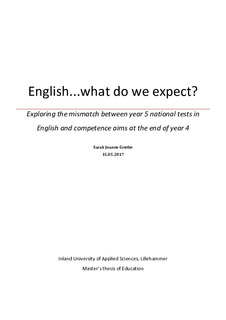English...what do we expect? : Exploring the mismatch between year 5 national tests in English and competence aims at the end of year 4
Abstract
The main objective of this thesis is to investigate and attempt to explain the mismatch between year 5 national tests in English and competence aims for the English subject at the end of year 4 in hope to justify frustrations experienced in the classroom as an English teacher. In order to achieve this objective I lay a foundation consisting of three components. Firstly, I show how the English subject is organized in Norway at the national and community level, specifically in lower primary education. Secondly, I explain what second language acquisition means in a classroom context and factors contributing to learning another language in this setting. Thirdly, I describe some of the components that make up reading assessments.
Next, I embark on an exploratory study which analyzes versions of the year 5 English national tests from 2009-2016 through the method of document content analysis. By analyzing several tests, I observe how content in tests has changed over time and how exercises on tests correlate (or do not correlate) to competence aims being tested. Conclusions of the document content analysis have shown changes in some of the types of exercises, an increase in overall word-count for some of the exercises and an increase in reading comprehension complexity throughout the years. Significant changes were seen between 2012 and 2013.
The fact that recent year 5 national tests in English, which are second language tests for 10-year-olds, focus primarily on reading comprehension when language learning competence aims focus on all four areas of language development can be a reason for the mismatch. Further, it is clear that competence aims are open to interpretation and various interpretations can justify the mismatch between expectations on year 5 tests in English and competence aims for the subject at the end of year 4.
